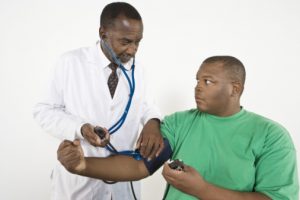
Your blood pressure reading has two values—systolic and diastolic. Systolic pressure is when the blood is forced out of the heart by its pumping action, while diastolic pressure is used to describe the compression between two heart beats.
When you finish exercising, your blood pressure will drop back to normal levels—we know that the time it takes for your blood pressure to return to normal is indicative of your health. So, the fitter you are, the quicker your blood pressure will return to normal.
If you have high blood pressure, check with your doctor first to ensure it’s safe for you to exercise. While it’s generally safe for most people, your doctor may want to lower your blood pressure levels with medication before sending you to the gym, just to be on the safe side.
What causes high blood pressure after exercise?
The normal range for blood pressure is between 90/60 and 130/80 mm Hg, while the average blood pressure is 120/80 mm Hg. It doesn’t sit at one number all day, as it’s constantly fluctuating depending on what you’re eating and what you’re doing. Physical activity increases your blood pressure, but it should drop down to normal levels soon after.
Your blood pressure increases because your heart is beating faster while working out in order to push blood out and supply oxygen to the muscles. Your systolic blood pressure will increase during exercise, but your diastolic one will only increase a little if you’re exercising at maximum heart rate.
Following exercise with a cooldown like low intensity walking or stretching will allow your blood pressure to gradually return to normal—however, if you just stop suddenly and lay on the couch, your blood pressure will drop drastically and blood will accumulate in your hands and feet.
Low blood pressure and exercise
When you’re exercising, your muscles have an increased need for oxygen, which is why your blood pressure increases during exercise. However, when you finish, your blood pressure may drop to less-than-normal levels, especially if you stop suddenly.
People who are already diagnosed with low blood pressure may experience associated symptoms when they work out. This just means that they need to avoid triggering exercises. If you have low blood pressure, you need to avoid exercises where your head is lifted suddenly from below the heart or exercises where it is leveled with your heart.
Try these exercises if you have low blood pressure:
- Pilates
- Jogging
- Swimming
- Walking
- Light weight-lifting.
Blood pressure and exercise chart
| Blood pressure level (mm Hg) | Ability to be more active |
|---|---|
| Below 90/60 | Low blood pressure. Speak to your doctor before exercising. |
| 90/60–140/90 | You can be more active but keep your blood pressure within this range. |
| 140/90–179/99 | Increase activity to lower your high blood pressure. |
| 180/100–199/109 | Speak to a physician before exercising. |
| 200/110 or above | Definitely do not exercise. Speak to your doctor. |
Does regular physical exercise lower blood pressure in the long term?
Regular exercise will help you lower your blood pressure permanently. Exercising makes the heart stronger, which lowers the amount of effort it has to make to pump blood. People who exercise regularly can reduce their blood pressure by between four to nine mm Hg.
It’s important to do activities that are not too strenuous—like the ones listed above—to avoid putting excess pressure on your heart. As long as your doctor has given you the green light on your exercise regimen, you’ll be safe to go.
Blood pressure and exercise: Precautions and healthy tips
To get the most out of your exercise regimen, it’s recommended to engage in vigorous exercise for 75 minutes a week, or moderate exercise for 135 minutes a week.
We often think of exercise as running or hitting the gym, but household chores count as exercise too. So, make sure you count in the scrubbing, mopping, sweeping, and other chores you do into the total amount of time you exercise.
If you have low blood pressure already, you need to make sure you stay hydrated. Drink two to three liters of water a day, and two more glasses of water before you exercise. Other options you may want to look into with your doctor are increasing your salt intake or wearing compression stockings.
However, if you do begin to work out and don’t feel great, and suspect it’s because of your blood pressure, either sit down or lie down and elevate your legs. Drink water immediately to increase your blood pressure.
All of this is to say that exercise is actually recommended for people with all sorts of blood pressure problems. It strengthens the heart, allowing it to work less to pump blood throughout the body, reducing overall stress. You’ll feel healthier, that’s for sure.
Related: Blood pressure differences when lying down, standing up, and sitting
Advertisement
On any matter relating to your health or well-being, please check with an appropriate health professional. No statement herein is to be construed as a diagnosis, treatment, preventative, or cure for any disease, disorder or abnormal physical state. The statements herein have not been evaluated by the Foods and Drugs Administration or Health Canada. Dr. Marchione and the doctors on the Bel Marra Health Editorial Team are compensated by Bel Marra Health for their work in creating content, consulting along with formulating and endorsing products.